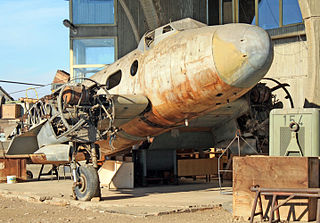
The Ikarus Aero 2 was a piston-engined military trainer aircraft built in Yugoslavia in the years following World War II, although the design pre-dated the war.
The Aero A.26 was a Czechoslovakian military reconnaissance biplane aircraft built by Aero Vodochody in the 1920s. It was Aero's last design to be based on the Hansa-Brandenburg B.I aircraft that the company had been building under licence during World War I as the Ae.10.

The Aero A.32 was a biplane built in Czechoslovakia in the late 1920s for army co-operation duties including reconnaissance and tactical bombing. While the design took the Aero A.11 as its starting point, the aircraft incorporated significant changes to make it suited for its new low-level role.

The Aero A.42 was a Czechoslovakian bomber aircraft of 1929 that was only ever produced in prototype form. For its day, it was an advanced design, with a sleek monoplane configuration. However, the Czechoslovak Air Force was not satisfied with it for a number of reasons. In particular, the aircraft's take-off and landing runs were felt to be excessively long, and crew complained about the cramped cabin. The air force suggested a set of modifications to Aero, including replacing the wooden wing with a metal one, but Aero discontinued development.

The Douglas O-46 was an observation aircraft used by the United States Army Air Corps and the Philippine Army Air Corps.

The UTVA 75 is a compact, low-wing monoplane, piston-engine aircraft manufactured by UTVA. It is mainly used as a military basic trainer and sporting aircraft.

The Soko 522 was a two-seater Yugoslav military training and light attack aircraft produced in the 1950s by SOKO in Yugoslavia.

The DINFIA IA 45 Querandi was a 1950s Argentine twin-engined light transport aircraft built by the DINFIA.

The Ikarus 214 was a military aircraft produced in Yugoslavia in the early 1950s. Originally intended as a light reconnaissance-bomber, it was produced as a trainer and transport aircraft when the testing of the prototype showed it had insufficient performance for the reconnaissance-bomber role.

PZL M-2 was a Polish trainer aircraft prototype of 1958, a low-wing monoplane with fixed gear. Designed at WSK-Mielec, it did not enter production.

The Utva Lasta 95 is a light military trainer aircraft produced by Utva Aviation Industry, subsidiary of Yugoimport SDPR. It is a tandem two-seater low-wing trainer with a metal airframe. The aircraft is capable of basic training functions including aerobatics, instrument and tactical flying, as well as basic training in use of weapons. The first prototype of Lasta 1 flew on 2 September 1985, while the first prototype of the current version, Lasta 3, flew on February 26, 2009. Lasta is the Serbian word for barn swallow.

The UTVA-66 is a STOL aircraft, which was produced in the former Yugoslavia. It was developed from the UTVA-60 and first flew 1966.

The Utva-65 Privrednik (Merchant) is a Yugoslav civil aircraft designed and used for agricultural work.
The UTVA-60 is a Yugoslavian light aircraft of the 1960s. First flying in 1959, it was built by UTVA for both the Yugoslavian armed forces and for civilian use.
The 105th Fighter-Bomber Aviation Regiment was an aviation regiment established in 1946 as 3rd Training Aviation Regiment as part of the Yugoslav Air Force.
The 461st Light Combat Aviation Squadron was an aviation squadron of Yugoslav Air Force formed in 1953 at Niš airfield as Training Squadron of 29th Aviation Division.
The 463rd Light Combat Aviation Squadron was an aviation squadron of Yugoslav Air Force formed in April 1961 at Titograd airfield as part of 105th Training Aviation Regiment. It has moved to Zadar military airport Zemunik later same year.
The 464th Light Combat Aviation Squadron was an aviation squadron of Yugoslav Air Force formed in April 1961 at Titograd airfield as part of 105th Training Aviation Regiment. It has moved to Zadar military airport Zemunik later same year.
The 465th Light Combat Aviation Squadron was an aviation squadron of Yugoslav Air Force formed in April 1961 at Mostar airfield as part of 105th Training Aviation Regiment. It has moved to Zadar military airport Zemunik later same year.

Utva 213 Vihor was a late 1940s Yugoslavian two-seat advanced trainer.














